I was at West 14th and 8th Avenue the other day when I decided to walk Bleecker Street from 8th Avenue all the way east to the Bowery, its entire length. Only two east-west streets can be said to extend from the West to the East Village — Bleecker does so, along with West 4th. Between 1829 and 1835, Herring Street and Asylum Street were renamed, respectively, Bleecker and West 4th. In each case, it was decided to extend an existing name in the Village northwest, eliminating two names. Similarly, at about the same time, Amos, Hammond, and Troy Streets were made extensions of West 10th, 11th and 12th Streets. As notated on the Greenwich Village Street Necrology, many Village streets had been named and renamed repeatedly before their present names were settled on, most by 1850 or so.
Bleecker Street begins (or ends; its house numbers are highest here and go down as you continue east) at Abingdon Square, where it meets 8th Avenue and Hudson Street. The square is named for the Earl of Abingdon, the son-in- law of Sir Peter Warren, a Royal Navy officer who owned much of the territory in the Village before the Revolutionary War. The square’s statue, dedicated in 1927 for its centennial, was sculpted by Philip Martiny.
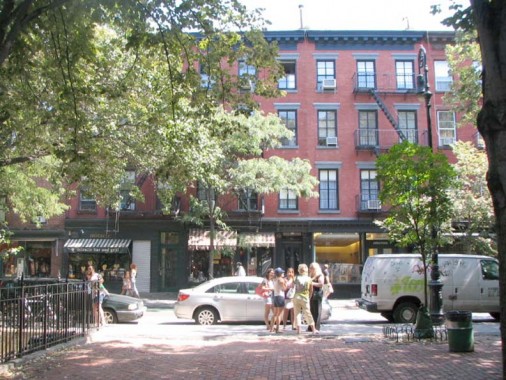
We are facing Bleecker Street from the Bleecker Street Playground, on a narrow sliver between Hudson, Bleecker and West 11th Street. It was opened in 1966 and is named, quite conveniently, for the street it faces. Anthony Lispenard Bleecker was an early 19th Century landowner and farmer. The Bleecker family donated land to the city in the area of today’s Washington Square Village west of LaGuardia Place. The Bleecker family scion, also Anthony (1770-1827) was an early NYC literary lion, whose work appeared in periodicals and journals of the era, and was a friend of Washington Irving and William Cullen Bryant; he was a founder of the New-York Historical Society. When the playground was constructed, it was, believe it or not, the first playground in the West Village. Famed author/preservationist/urbanist Jane Jacobs and her husband, architect Robert Jacobs, resided at nearby 555 Hudson Street.
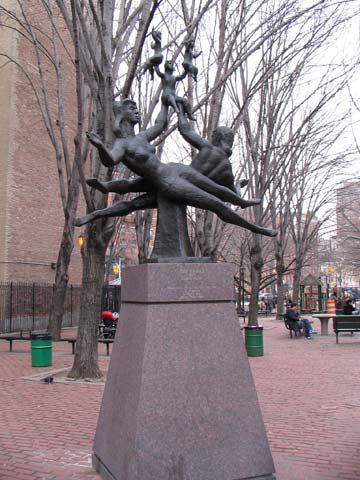
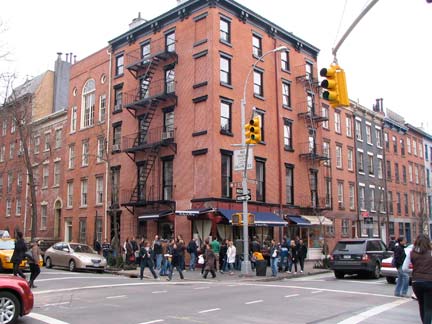
At Bleecker and West 11th is Polish sculptor Chaim Gross’ statute The Family, completed in 1979 and dedicated in 1992 in this location. It was a gift of the artist, who lived nearby, in honor of Ed Koch’s three terms as mayor between 1978 and 1990.
On the southeast corner is the Magnolia Bakery, whose cupcakes were made famous in the Sex and the City TV show. Your webmaster is a Hostess man. Book lovers gravitate to Biography across the street, at least till it relocates to 266 Bleecker in 2010.

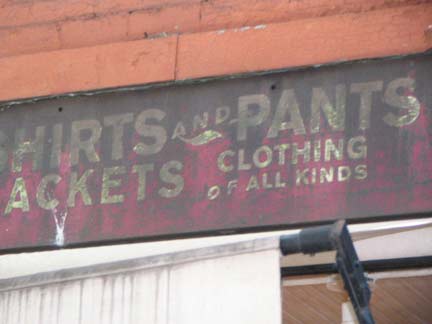
In 2001 Bleecker Street between West 10th and West 11th (three blocks) started becoming the home of some high-end clothiers, such as Marc Jacobs, who has acquired the Biography Bookstore space, and Ralph Lauren. RRL Ralph Lauren (the designer was born Ralph Reuben Lifshitz in the Bronx; his family name was changed to Lauren when he was a teenager) cleverly acquired, from the looks of things, an older store called RRL & Co. Its old sign has ben preserved on the awning, though perhaps it’s a new sign made to look old — in which case the joke’s on me.
Your webmaster usually gets his duds from K-Mart or Robbins Men’s and Boys’, or if there’s a special occasion, there’s always Sy Syms. However my eyes were drawn to this second Ralph Lauren storefront because there are some vintage subway signs in the window.
There’s only one Bushwick Avenue stop in the subways, on the BMT Canarsie Line, and the stop is a somewhat obscure one with interesting tiling on the station columns. (Indeed the entire Canarsie Line is can’t miss for station tiling and mosaic buffs.) In addition, at left is a roll sign used in subway cars, I’d estimate, between the 1940s and 1960s. Note Hudson Terminal on the bottom, the old name for today’s World Trade Center Terminal, the southernmost stop on the E train.
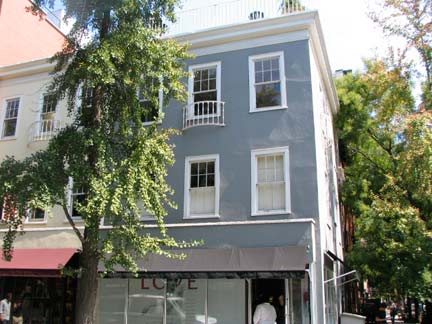
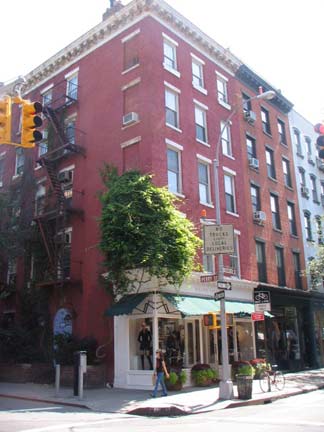
A pair of mid-19th Century houses on the NE and SE corners of Perry Street. Sir Peter Warren’s estate was located on what would be the block between Bleecker and West 4th on Perry Street. The mansion survived, surrounded by the present row houses, until 1865. Perry Street was named for War of 1812 hero Commodore Hazard Perry (“We have met the enemy and they are ours”).
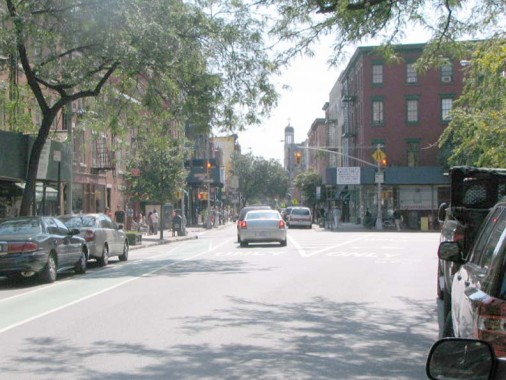
At Christopher Street, Bleecker widens briefly and turns gently east-southeast, beginning a general eastward turn that will actually point east-northeast by the time the street reaches The Bowery. According to the Manual of the Corporation of the City of New York, the widening was done in 1827 when Bleecker was still called Herring Street, necessitating the removal of three houses, and apparently was done as part of the straightening of Grove Street, one block south of Christopher (which was a road to the river as far back as colonial days when it was called The Skinner Road.)
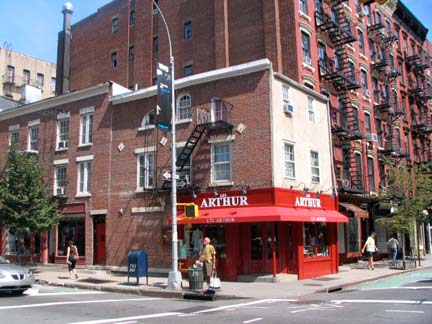
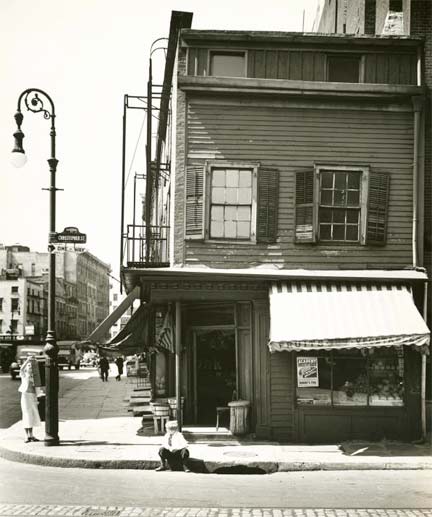
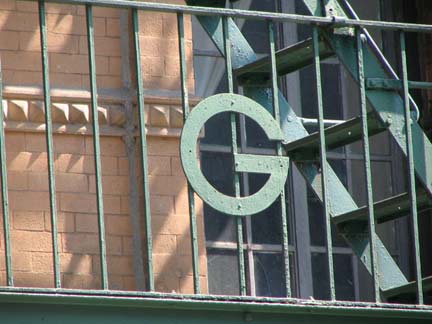
The small 2-story building at the NE corner of Bleecker and Christopher, #329, is one of the oldest in Greenwich Village; it was constructed during the Jefferson adminsitration. It was photographed about 1935 by Berenice Abbott. Note the small mailbox on the lamppost — only a few of these were still in existence when I began FNY in 1998, and I believe all of them have now disappeared. Photo from NYPL collection.
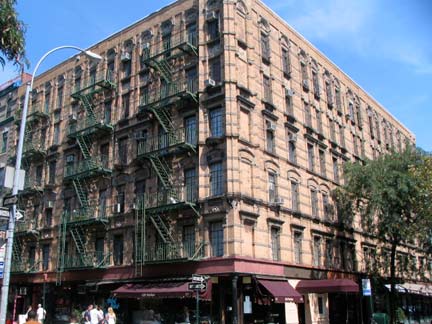
The handsome 6-story apartment building at Bleecker and Grove contains fire escapes on the Bleecker side all festooned with letter G’s. G for Grove? Are the G’s new additions? They bear a striking resemblance to the capital G in the Avant-Garde font, designed for use in Avant-Garde Magazine from 1968-1971.
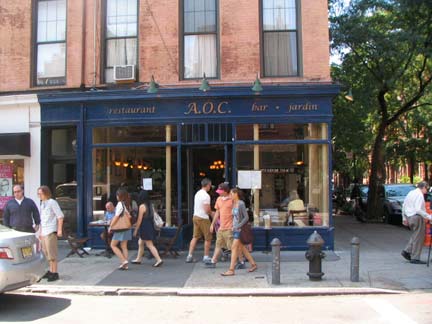
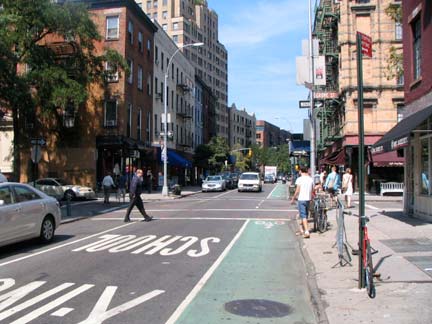
I recently ate at the French restaurant A.O.C., formerly The Grove, whose old exterior dining area is still in the rear. The title is an abbreviation for l’aile ou la cuisse, “the wing or the thigh.” The title also refers to a French film comedy in 1976 in which a restaurateur champions traditional fare over processed junk. Below, Bleecker Street’s bike lane, which runs for its entire length. It was recently given a new paint job.
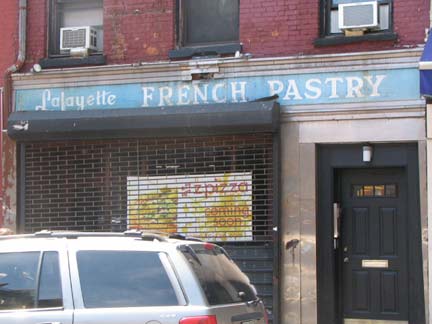
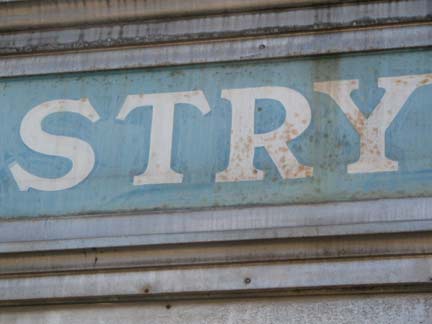
Just prior to its intersection with Barrow, an awning was taken down recently (for my favorite cheap taco chain, Burritoville, actually), revealing a sign for a long gone pastry shop beneath. The hand-lettering is meticulously rendered.

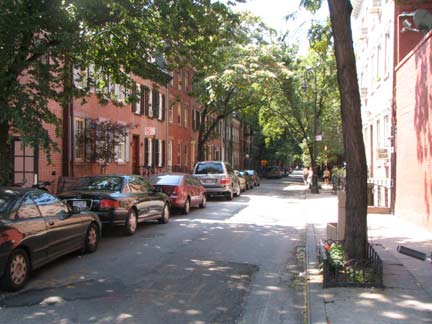
Across the street at 309 Bleecker was one of the final residences of activist pamphleteer Thomas Paine, whose treatises “The Crisis” and “Common Sense” argued for American independence from Great Britain. In Thomas Janvier’s In Old New York, he recalls the recollections of Paine’s neighbor, John Randel (one of the surveyors who drew up the Commissioner’s Plan instituting a street grid system on Manhattan Island in 1811):
“I boarded in the city and in going to the office I almost daily passed the house…where Thomas Paine resided, and frequently in fair weather saw him sitting at the south window of the first-story room of that house. …His right hand lay upon his book, and a decanter containing liquid of the color of rum or brandy was standing next to his book or beyond it. I never saw Thomas Paine at any other place or any other position…”
In the last month of his life Paine moved to bigger quarters in a frame house on what would become Grove Street after that street was put through a few years after his death. In that spot presently stands a 4-story wood framed house home to piano bar Marie’s Crisis, cleverly named for one of Paine’s works. In 1923 the defunct Greenwich Village Historical Society erected a memorial plaque.
Meanwhile, Barrow Street was, for a time in the early 1800s, called Reason Street, after “The Age of Reason,” written by Paine in a French prison during the Revolution’s Reign of Terror.
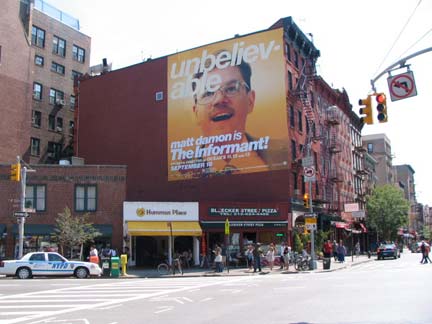
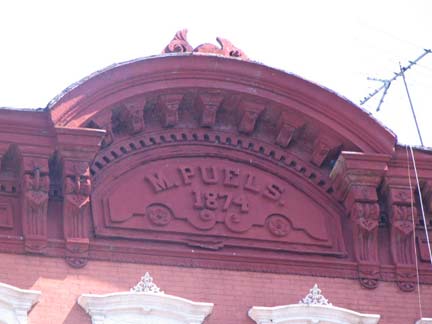
Matt Damon is bigger than ever on Bleecker and 7th Avenue South in a large ad for his fall 2009 vehicle The Informant. An adjoining Bleecker tenement helpfully includes the date of construction and, presumably, the builder, on its cornice. It would be a good idea if present-day buildings would resume this practice.
6th Avenue south of Carmine Street and 7th Avenue South are 20th-Century incursions of the street grid of northern Manhattan into the quiet Greenwich Village street layout, as each brought pedal to the metal traffic to the previously sleepy village. Both are direct consequences of subway construction, as the IND and IRT were bruited into the underground fabric. There is an inconsistency about the two avenues’ street numbering, as 7th Avenue South merely continues Varick Street’s numbering north of Clarkson when it was built between 1910-1915. 6th Avenue, though, wasn’t given a “South” version — when it was extended south from Carmine to Church Street in 1928, it was renumbered along its entire length, so that the lowest address shifted from Carmine to Church.
The extension of 7th Avenue South in a north-south axis really cut a swath through Greenwich Village’s SW-NE grid orientation, and some very odd streetscapes were created. For example, the intersection of Barrow, Bleecker and 7th Avenue South produces a total of six corners.

The storefront Ottomanelli & Sons alerts us that we are now traveling through Greenwich Village’s Italian district. The butcher, specializing in game, has been in business since the 1930s.
Known for its freshly ground meat, grass-fed beef, poultry, and game, Ottomanelli’s operates five butcher shops and restaurants in the city. Nicolo Ottomanelli, who with his brother Joseph is chairman of the company, said his grandfather founded the business in 1900 with a pushcart on Delancey Street. NY Sun
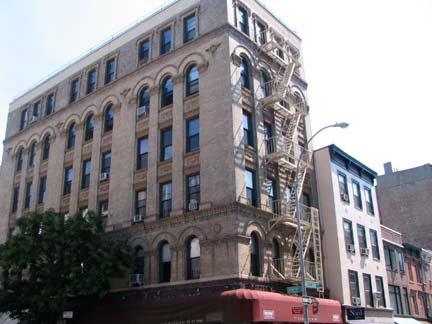
Bleecker Street features man handsome Beaux-Arts apartment buildings along its length. This one is at the corner of one-block Jones Street.
When Bob Dylan lived in Greenwich Village in the early 1960s, he and then-girlfriend Suze Rotolo walked down Jones Street for a photo shoot for the cover of his second long-player, The Freewheelin’ Bob Dylan.
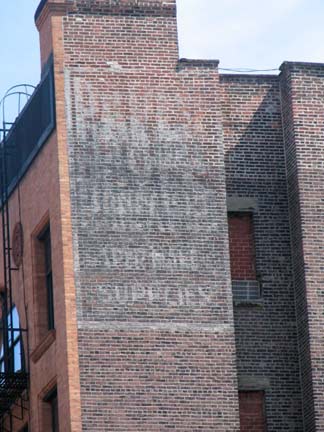
A very faded Jones Street ad. I think it advertises paper and twine supplies.
Part of Bleecker Street’s charm is the presence of longstanding businesses who have been supported by residents for decades, instead of impersonal chain stores. John’s Pizza has been here since 1929, enough time to craft a recipe that is recognized by many as NYC’s best pizza, though that honor is largely subjective. Original owner John Sasso learned the craft from NYC’s first pizzaiolo, Gennaro Lombardi, whose pizza place can still be found on Spring Street.
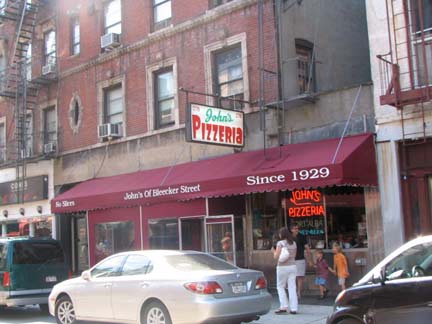

Bleecker, along this stretch between 6th and 7th Avenues, is where many streets begin and end. Morton and Leroy arrive from the Hudson River to have their northeastern progress ended here, while Jones and Cornelia, two of the Village’s one-block streets, start northeast. The stretch of Bleecker shown here, between 6th and 7th (South) is home to many used-record shops, while Matt Umanov’s guitar shop has been well-known among NYC musicians for nearly 45 years.
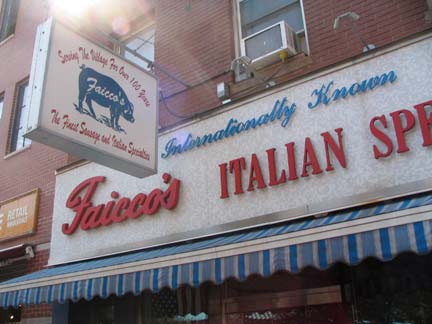
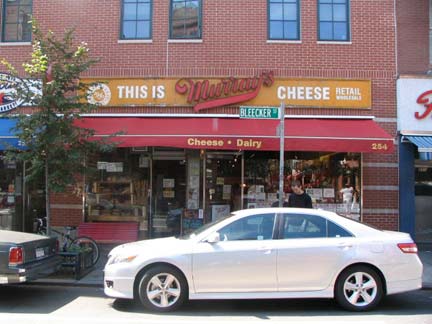
Like Ottomanelli, Faicco’s, here since 1927, is a butcher but it specializes in pork cuts. Its sausage heros are renowned in the Village. The adjoining Murray’s Cheese Shop was opened by Spanish Civil War veteran Murray Greenberg in 1940.
It’s the type of place New Yorkers brag about – a real institution, a place serieux where the ownership and management is obviously obsessed with what they do and have a tremendous drive to be the best. In a city as large as New York, these specialized niche retailers can really thrive. Murray’s was founded in 1940 by Murray Greenberg, starting as a wholesaler of butter and eggs. Rob Kaufelt, the current owner, bought the business from Louis Tudda in 1991. In 2004, they moved from a much smaller cramped location across the street to their current space, where they purchased the building. They lease adjoining retail spaces to other high quality food retailers, (Amy’s Bread and Wild Edibles.) Murray’s retails over 250 varieties of cheese and wholesales to 75 restaurants, including many of the city’s finest. I was fascinated to learn of their authentic underground cheese caves where affinage (the art of aging) is practiced (Murray’s was one of the first cheese retailers in the U.S. to do this) – French affineur Herve Mons was consulted in their construction. Kaufelt travels the world to acquire cheese and has forged relationships with many artisanal cheese makers and is able to introduce these special cheeses to their American customers. NY Daily Photo
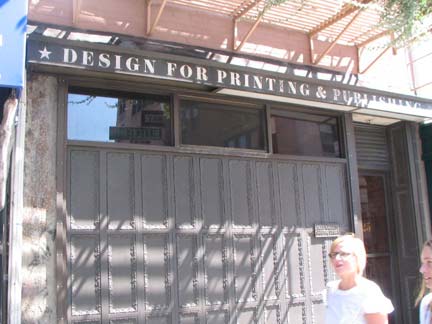
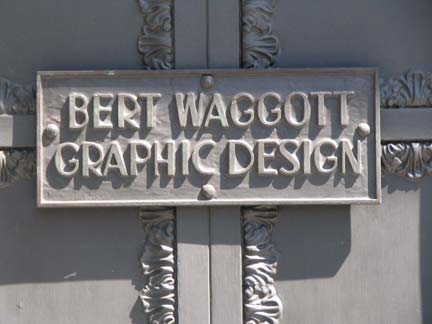
I was intrigued by this Bleecker storefront at 251, “Design for Printing & Publishing” and the wrought-iron signature “Bert Waggott Graphic Design.” Bert Waggott is an Adjunct Professor at Pratt Institute in Brooklyn.

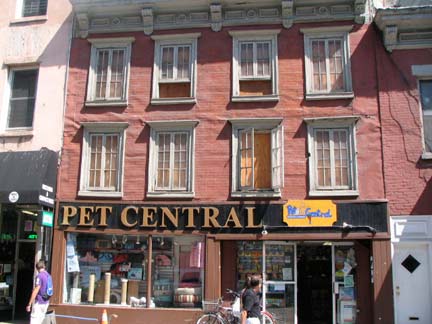
In the Super Seventies and Easy Eighties I could often be found emerging from Bleecker Records and other Village locales with bulging stacks of wax, some of which I still own. This, by the way, isn’t Bleecker Bob’s, which is on West 3rd Street. The record store and Pet Central, next door, are in some very old Bleecker Street buildings, with the Pet Central building a rare wood frame coach house constructed in 1830.
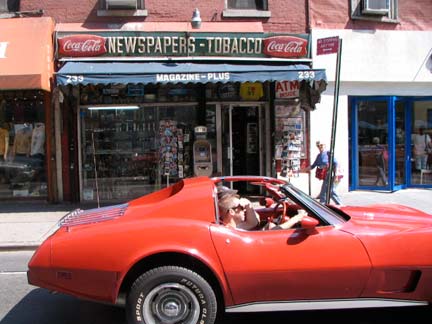
Name that car! A classic scene with a sports car passing in front of an old fashioned grocery sign.
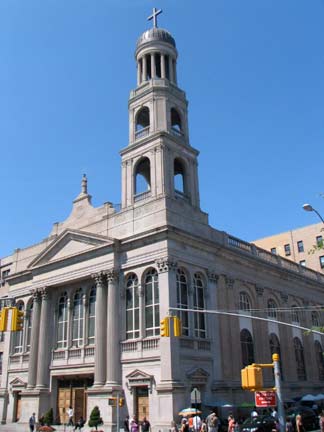
Our Lady of Pompeii Church, constructed in 1928 and replacing an older church that was in the path of the IND Subway construction.
ForgottenFan Don Brunjes on the grocery store sign: You can tell by the “Fishtail”, also known as the “Arciform” Coke logo. Came out in late ’59 and was used by the brand for a solid 10 years. The yellow tin letters on green background were offered to shopkeepers by local Coca-Cola bottling companies. The letters were attached the green portion of the sign to spell out whatever the vendor wanted and are referred to as the “privilege panel”.
ForgottenFan Joe Hedio: That red car that you asked about in your latest post on Bleecker Street is a 1974-1977 Chevy Corvette. The back bumper is color coordinated w/the rest of the body, instead of having chrome bumpers in the earlier models, since it was one of the 5-mph federally mandated bumpers.

The recently reconstructed Father Demo Square, where Bleecker meets Carmine Street and 6th Avenue, was named for the pastor who saved OLOP. From my Deep Sixth FNY page:
Father Antonio Demo bought the parcel at Bleecker and Carmine Streets that had earlier hosted a vaudeville hall and St. Benedict the Moor, the first black Catholic church in the city. Mother Frances Cabrini, commemorated with one of Manhattan’s few “boulevards” in Washington Heights, was a parishioner. Our Lady of Pompeii has Mass, confession, sacraments and a weekly radio program in Italian. Mayor Fiorello LaGuardia named the triangle formed by Sixth, Bleecker and Carmine for Father Demo in 1936.
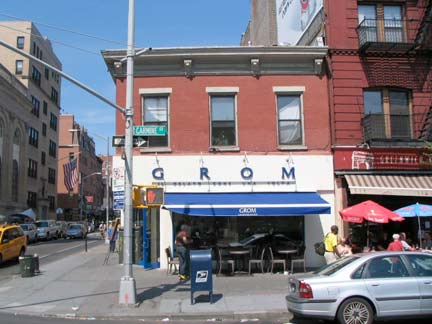
GROM Gelato, replacing the earlier Joe’s Pizza (ambiguous names instead of straightforward ones are sometimes deemed cooler) occupies the ground floor of an 1822 wood frame house. Carmine was formerly the southern limit of 6th Avenue.

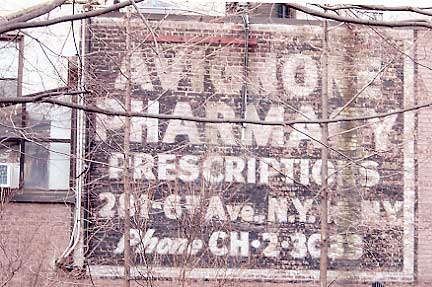
Avignone Pharmacy, which has since adopted the classier (it’s British!) moniker Chemists, has had a huge painted ad in adjoining Churchill Square since time immemorial, or perhaps the Fab Forties.
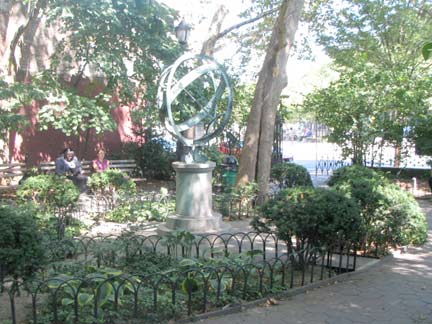
The triangle formed by 6th Avenue, Bleecker and Downing Streets has, probably influenced by Downing Street (the site of the Prime Minister’s residence in London is #10 Downing Street) been named Sir Winston Churchill Square. Churchill, of course, was England’s inspirational PM during World War II. His mother, Jennie Jerome, and grandfather, Leonard Jerome, were New Yorkers.

The sitting area, designed by George Vellonakis, was rebuilt from 1998 to 1999 to incorporate garden spaces, a pedestal mounted armillary and a decorative, gated iron fence. The Bedford Downing Block Association continues to be an important force behind the maintenance and upkeep of Churchill Square, ensuring that it remains the peaceful oasis that it is now for years to come. NYC Parks
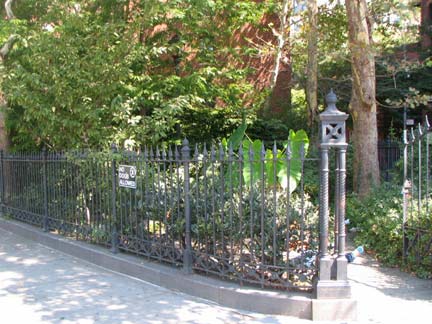
Yet another public space, Minetta Triangle, can be found across 6th Avenue, at the triangle formed by 6th Avenue and Bleecker and Minetta Streets. Minetta Street runs atop the underground Minetta Brook. George Vellonakis also designed this small garden space. Vellonakis, in fact, is the chief designer behind the controversial Washington Square redesign.

Porto Rico Importing (coffees and teas) has been in business since 1907, when the USA commonwealth was usually spelled “Porto” not “Puerto” on maps.
Bleecker Street, once passing 6th Avenue, now takes a generally eastward turn, taking its place between Houston Street to the south and 3rd Street to the north.
Little Red Schoolhouse, SE corner 6th Avenue and Bleecker Street. The school and Elisabeth Irwin High School, founded in 1921, bills itself as progressive, the sitting area is called Little Red Square, and its roster of graduates can make up an all-star team of 1960s radicals, among them Weatherwoman Kathy Boudin and revolutionary/author Angela Davis. Boudin became a public health advocate while in prison after her conviction for her role in the robbery of a Brinks truck in 1981; Davis was celebrated by The Rolling Stones.

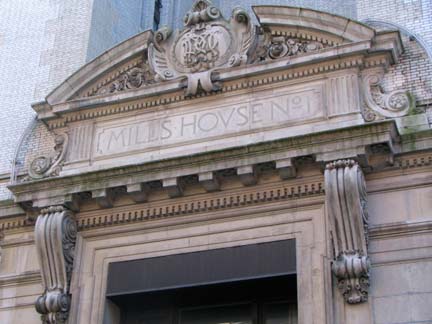
The huge, Beaux Arts Mills House No. 1 looks somewhat out of place on Bleecker, filling the south side of the block between Sullivan and Thompson Streets. As ornate as it is, it was built in 1892 to provide housing for the destitute. Ernest Flagg, who built Bay Ridge’s Flagg Court and a vast estate on Staten Island, was one of the architects. The apartments descended into decrepitude before the building was converted to more upscale housing in 1976.
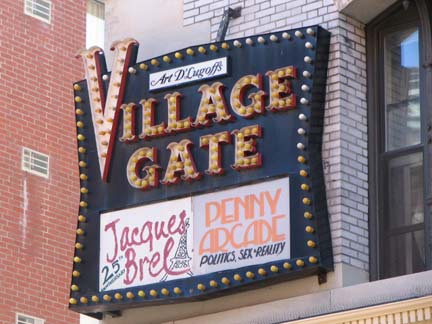
Concert producer Art D’Lugoff opened the Village Gate in the Mills House in 1958 and it lasted until 1993. The musical Jacques Brel Is Alive And Well… premiered here in 1984. Over the years, the Village Gate has hosted concerts by Harry Belafonte, Pete Seeger, Dizzy Gillespie, Charles Mingus, Thelonius Monk, John Coltrane, and Aretha Franklin, and hosted Macbird, One Mo’ Time and Scrambled Feet, among others. The concert space is now used by a performance space/bar called Le Poisson Rouge.
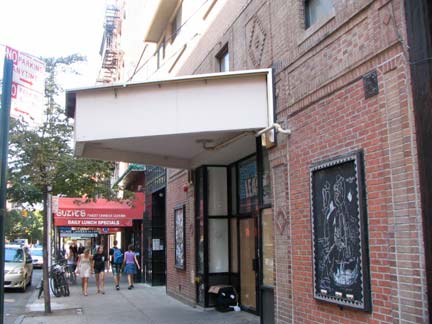
Across the street you can still see a marquee marking the location of the old Circle In The Square Theatre, which has since moved to the Paramount Plaza complex in Times Square.
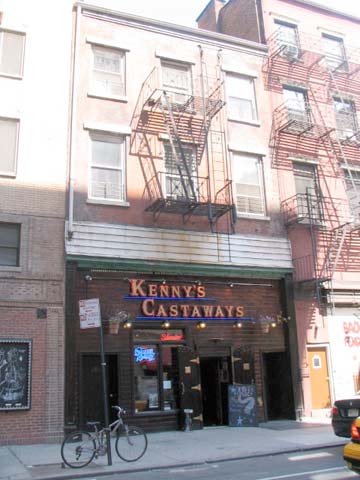
Kenny’s Castaways, opened in 1967 by Patrick Kenny, has hosted Aerosmith, Bruce Springsteen, Patti Smith, the New York Dolls and Phish over the decades. The interior is little changed from when it was an 1820s boite, The Slide, called by The Press in 1890 “the wickedest place in New York.”
[Kenny’s closed its doors in October 2012]

The Back Fence has been at Bleecker and Thompson even longer, having opened in 1945. These days the acts are a mix of country and pop.

Yet another venerable comedy, folk and rock club, The Bitter End, opened in 1961. How many acts can you recognize on their photo page with owner Paul Colby? I see Carly Simon, Les Paul, Billy Preston, Bob Dylan, Peter, Paul & Mary, Andy Gibb, George Thorogood, Billy Swan, and Linda Ronstadt. Comics appearing here were huge names such as Bill Cosby, Woody Allen, George Carlin, Richard Pryor, and Joan Rivers. I have seen my pal Paul Stingo’s band The Peaces here.
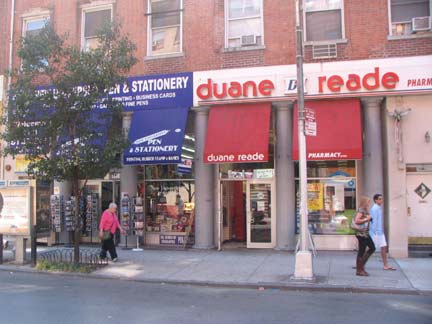
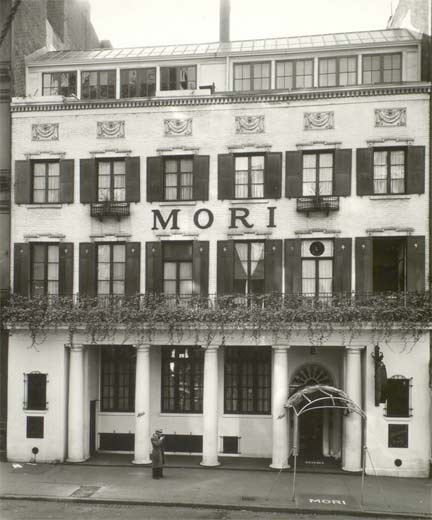
The Doric columns are still there from the Mori Italian restaurant (opened in the 1880s) at 144 (photographed by Berenice Abbott) but nothing else remains either from Mori or the Bleecker Street Cinema, which occupied the space for decades (till 1990) after Mori closed in the 1930s. Kim’s Video Underground was the latest famed occupant.
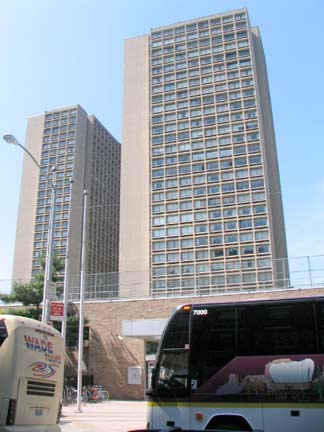
Bleecker Street between LaGuardia Place (which Robert Moses had hoped to connect to Fifth Avenue as a major link to his proposed Lower Manhattan Expressway, which was to run on Broome Street) and Mercer Street has completely different look and feel than any other of Bleecker’s blocks, as its apartment and tenements were razed in the early 1960s to make way for the high rises Washington Square Village and the Silver Towers. The towers occupy what was, in the mid-1800s, called Frenchtown.
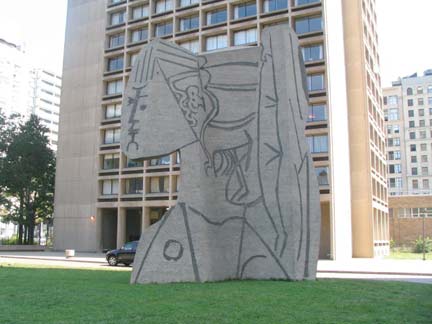
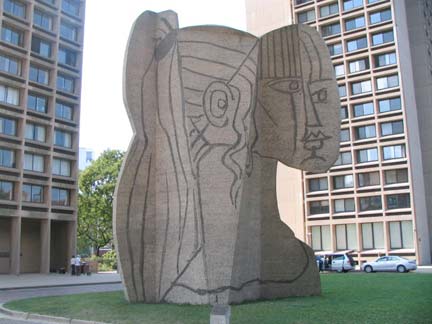
Hidden away on the grounds of I.M. Pei’s Silver Towers (completed in 1966) you fill find an honest to goodness Pablo Picasso. Archiect I.M. Pei commissioned the great Spanish artist to enlarge a smaller work done in 1934, Bust of Sylvette, to a 36 by 20-foot slab, and it was executed by Norwegian sculptor Carl Nesjär in 1968.
Christo, who wrapped Central Park in orange in 2005, did a special here in 1972.
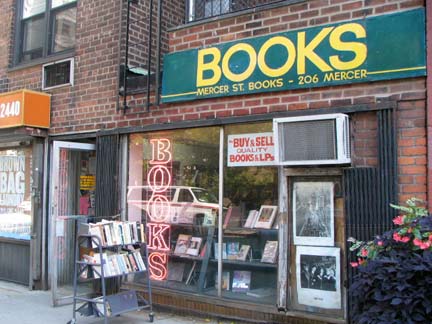
Mercer Street Books, one of NYC’s indie bookshops. Today (9/12/09) I attended the Brooklyn Book Festival, an annual affair held at Brooklyn Boro Hall, and noted that there are many, many more indie bookshops than I suspected. My most successful book tour appearance in October 2006, was at Freebird in Cobble Hill. But the major chains have done right by the ForgottenBook as well.
Back in the 1980s, I stumbled in here looking for some vinyl and I was mistaken for Jack Casady, the Jefferson Airplane bass player. I didn’t take advantage and ask for freebies.
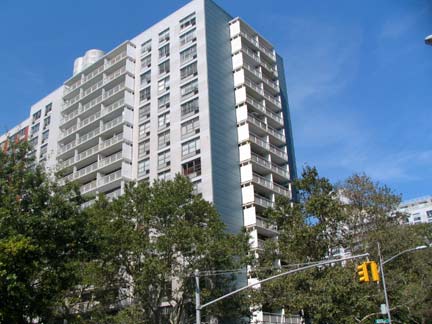
Washington Square Village.
Manhattan Savings Institution, NE corner Bleecker and Broadway. Were New York City’s greatest buildings built around 1890, give or take 2 years? In my opinion, they were. The MSI dates to 1889-90 by architect Stephen Decatur Hatch.
Jim Naureckas, NYC Songlines: An earlier MSI building was the site of the 19th Century’s biggest bank robbery. Carried out by the King of the Bank Robbers, George Leonidas Leslie, on October 27, 1878, with a gang that included such notables as Jimmy Hope, Shang Draper, Red Leary, Johnny Dobbs, Worcester Sam Perris, Banjo Pete Emerson and Eddie Goodie Gearing. They made off with over $2.7 million; unfortunately for them, all but $12,000 was in non-negotiable bonds.
The Swatch storefront has nothing to do esthetically with the architecture above it, but I like this 1970s-style treatment anyway. And pale yellow is one of my favorite colors. The “secret entrance” in front goes to a subterranean store.
As rococo as the Bayard-Condict Building at Bleecker and Crosby Streets is, it’s regarded as a precursor to the skyscraper boom that commenced with the Flatiron and then Woolworth Buildings in the early 20th Century. And, the relatively large windows look ahead to the glassy International Style that commenced mid-century. This is the only building in NYC designed by Chicago architect Louis Sullivan, whose pupil, Frank Lloyd Wright, would design buildings that broke away from the ornate Beaux Arts style completely.
The MTA is doing a lot of work at the IRT Bleecker Street station and the IND Broadway-Lafayette, knocking down walls to enable a transfer in both directions (Since the IND station was built in the 1930s, only a transfer to the IRT downtown was available.)
[That transfer finally opened in September 2012]
The Bleecker Street blue station ID tablets are amongst the most gorgeous station identifiers in the NYC subway.
New staircases have been designed to look like older ones. A 1930s Art Moderne entrance can still be found on the NW corner of Bleecker and Lafayette.

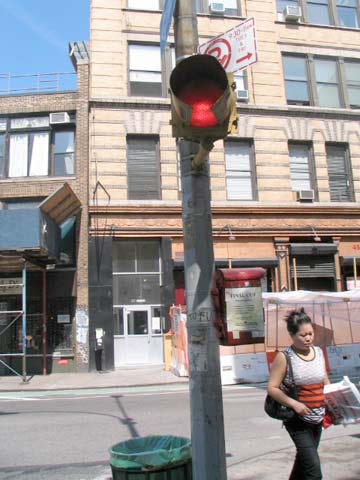
A pointy triangle building is at the very slim space formed by Mulberry, Bleecker and Lafayette. Mulberry approaches Lafayette at a slight angle but never quite reaches it — Bleecker cuts it off. Mulberry’s approach is regulated by a single Cyclops blinking traffic signal.
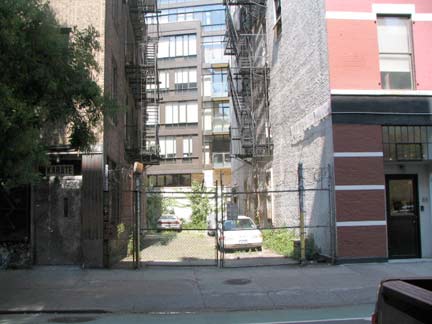
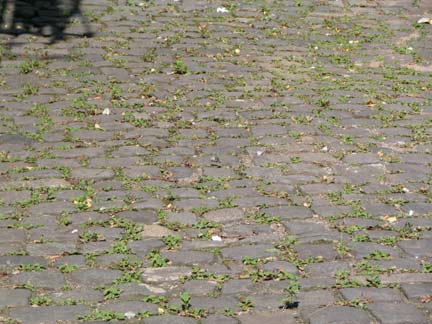
 The L-shaped extension of Jones Alley that bends from Lafayette Street south to Bleecker is currently gated off, but you can still see the Belgian block pavement. Traditionally, this has been called Shinbone Alley, and the city even used to mark it as such, but the sign kept getting stolen. So I’ll make a sign. The adjoining 33 Bleecker is on the site of Herman Melville’s boyhood home. Jones and Shinbone Alleys were originally laid out as stable access in the 1800s.
The L-shaped extension of Jones Alley that bends from Lafayette Street south to Bleecker is currently gated off, but you can still see the Belgian block pavement. Traditionally, this has been called Shinbone Alley, and the city even used to mark it as such, but the sign kept getting stolen. So I’ll make a sign. The adjoining 33 Bleecker is on the site of Herman Melville’s boyhood home. Jones and Shinbone Alleys were originally laid out as stable access in the 1800s.
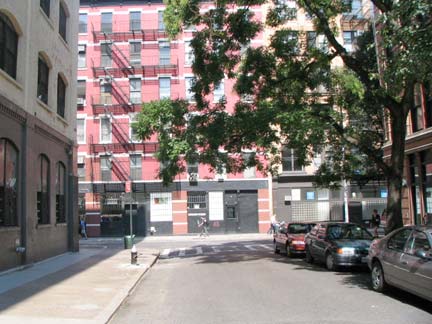
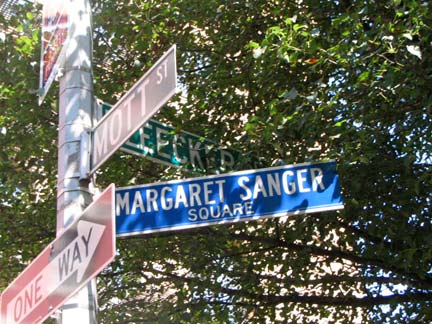
Mott Street, along with Little Italy’s Mulberry and Elizabeth Streets, end their northbound run at Bleecker. Since 1991 the corner of Mott and Bleecker has been named for the founder of Planned Parenthood, which has its administrative offices here.
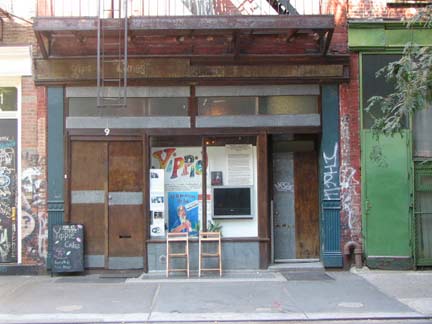
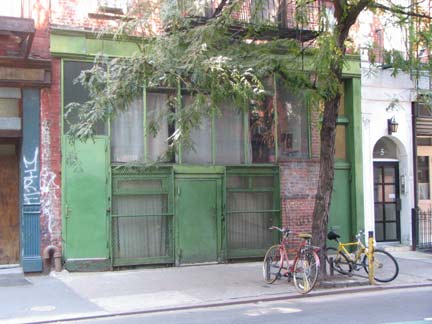
Yippies. From my first Bowery page:
Counterculture/antiwar group the Yippies, led by ?Abbie Hoffman (1936-1989), ?moved to #9 Bleecker in 1973 after a stint at Union Square. When the building was sold in 2000 the group faced eviction, a partnership was formed allowing the group to stay on. Plans call for the building to become a “Yippie museum” and an advocacy center to fight transmission of AIDS.
#7 Bleecker, one of the oldest on the street, was built in 1816. Photographer Robert Frank has a studio here.
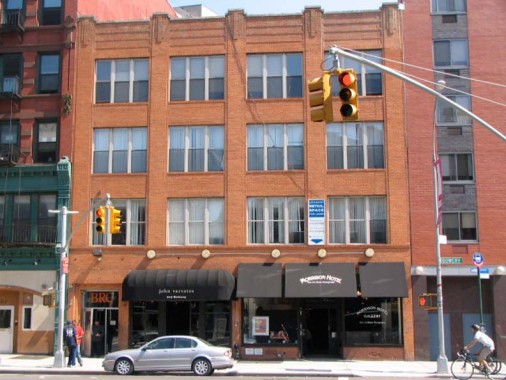
From 1973-2006 the ground floor of 315 Bowery, facing Bleecker, was home to CBGB. I only was in there a couple of times, but followed closely the careers of several bands who made their names here in the early days: Television, Talking Heads, the Ramones, Blondie. It’s with just a touch of melancholy that I note that the world these bands inhabited has been obliterated by luxury development the past few years. But scenes develop constantly, some out of nowhere. If you told me in 1985 there would be a thriving music scene in Williamsburg in just a decade’s time, I’d’ve called for the men in the white coats and butterfly nets. Today, designer John Varvatos and the mockingly? named Morrison Hotel gallery occupy the old rock club spaces.
SOURCES:
Greenwich Village and How It Got That Way, Terry Miller, 1990 Crown; In Old New York, Thomas Janvier, 1894 Harper




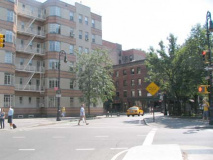
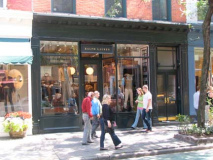
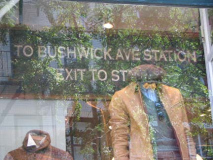

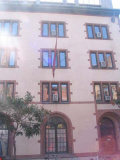
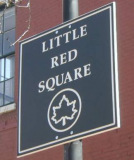
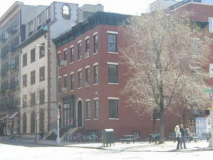
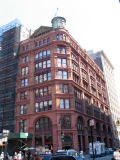
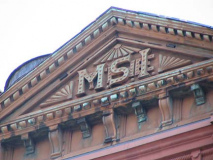
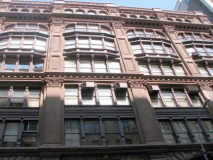
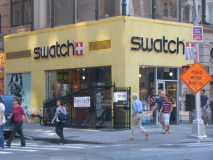
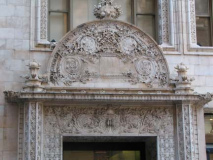
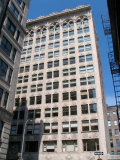
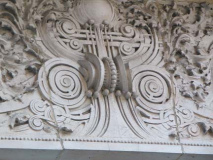

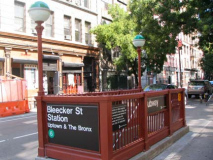
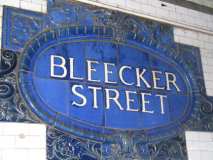
4 comments
[…] Here’s a fantastic, photo-studded blog post detailing Bleecker Street. […]
[…] Bleecker Street […]
[…] do some serious shopping : the Bleecker Street, the Chelsea Market, the 5th […]
[…] Forgotten NY says this about John’s: Part of Bleecker Street’s charm is the presence of longstanding businesses who have been supported by residents for decades, instead of impersonal chain stores. John’s Pizza has been here since 1929, enough time to craft a recipe that is recognized by many as NYC’s best pizza, though that honor is largely subjective. Original owner John Sasso learned the craft from NYC’s first pizzaiolo, Gennaro Lombardi, whose pizza place can still be found on Spring Street. […]
Comments are closed.